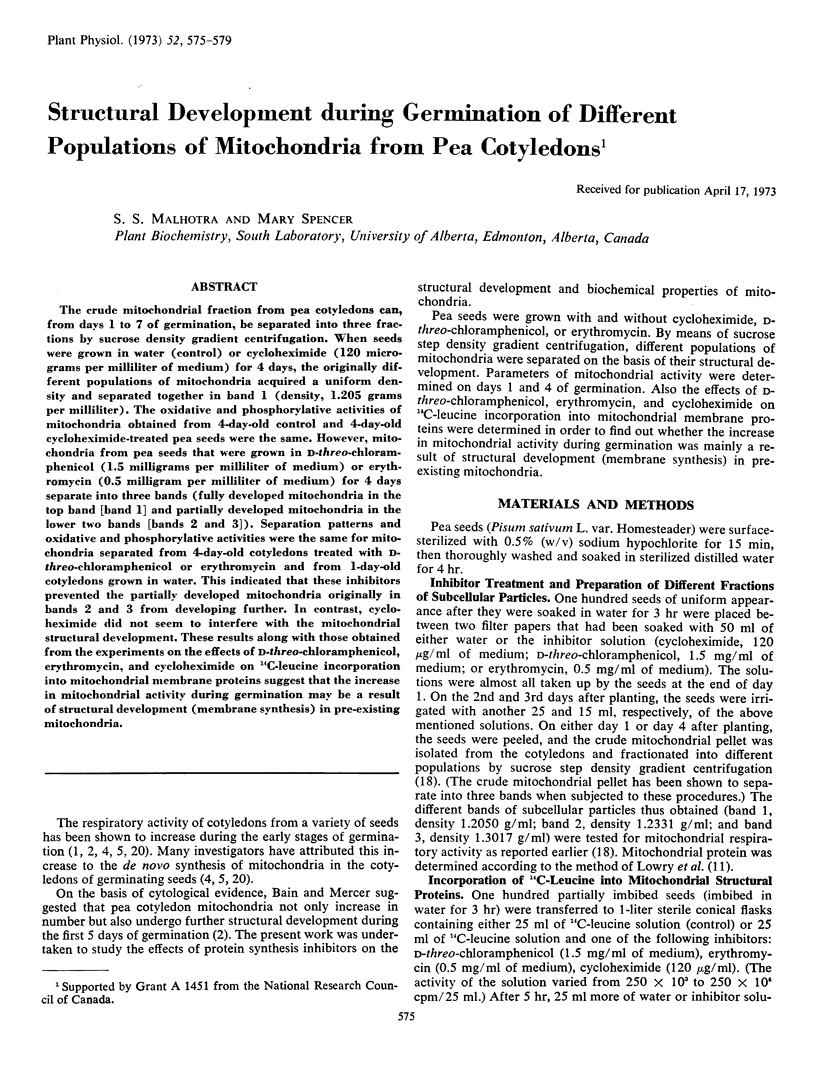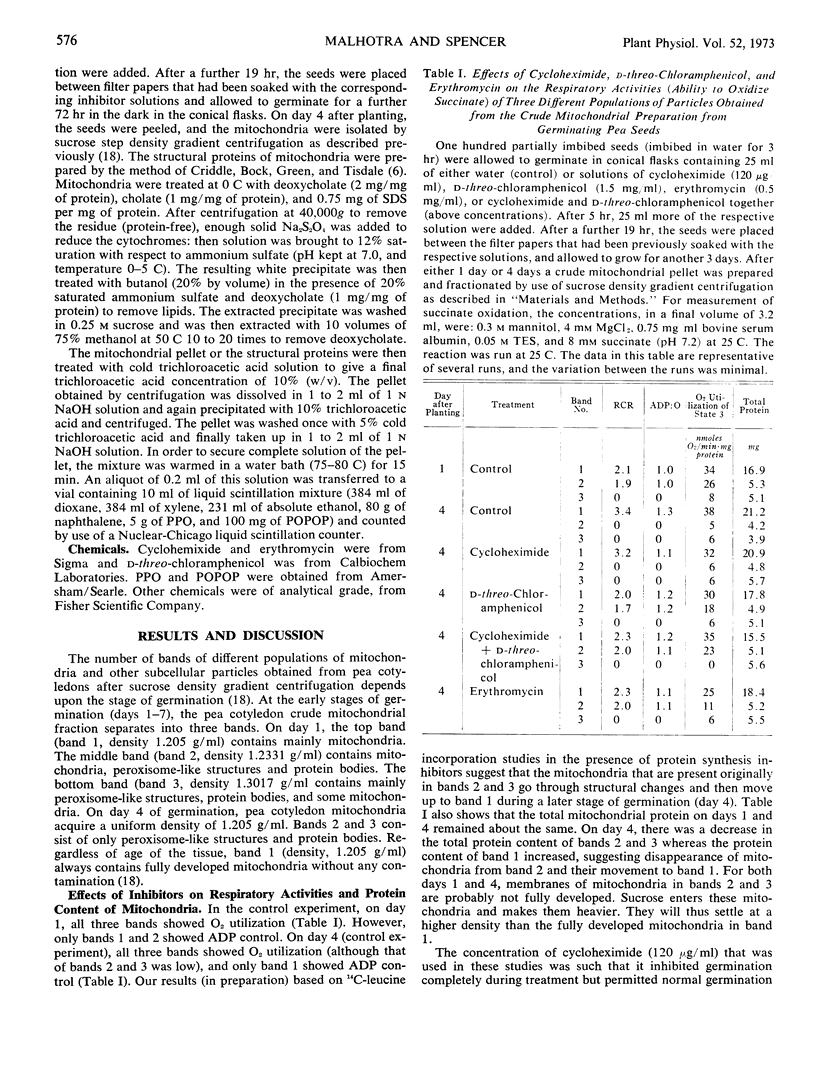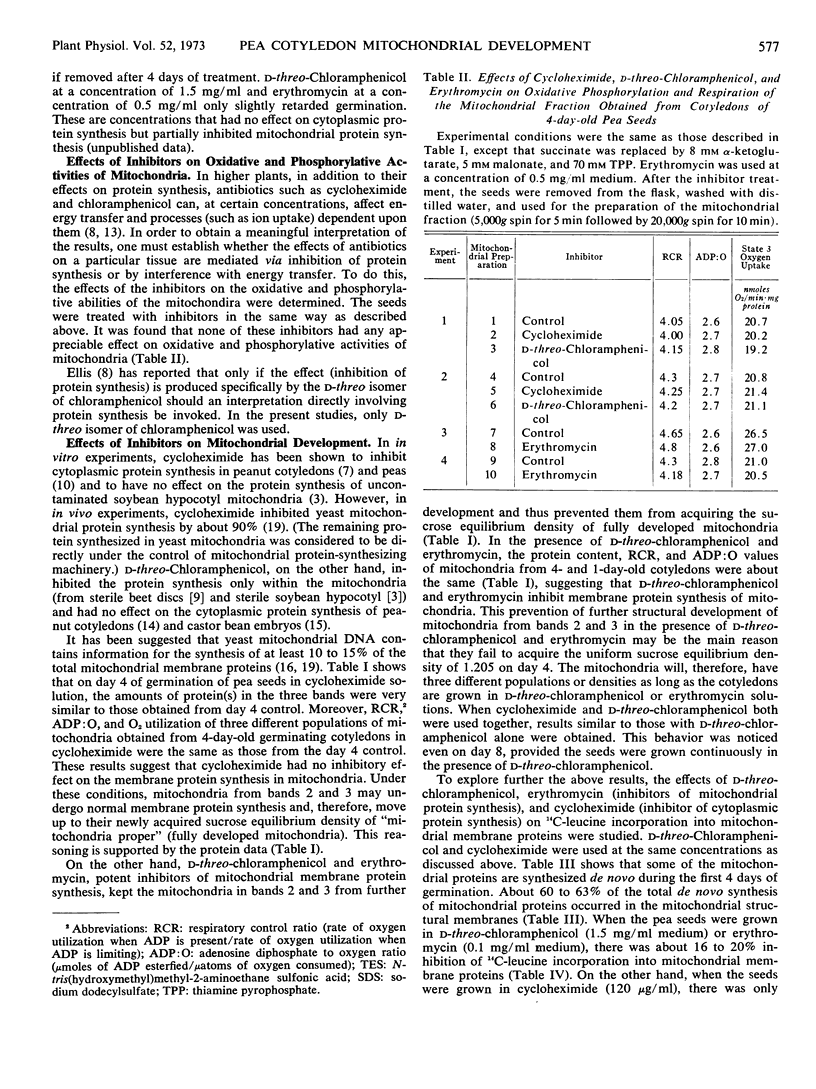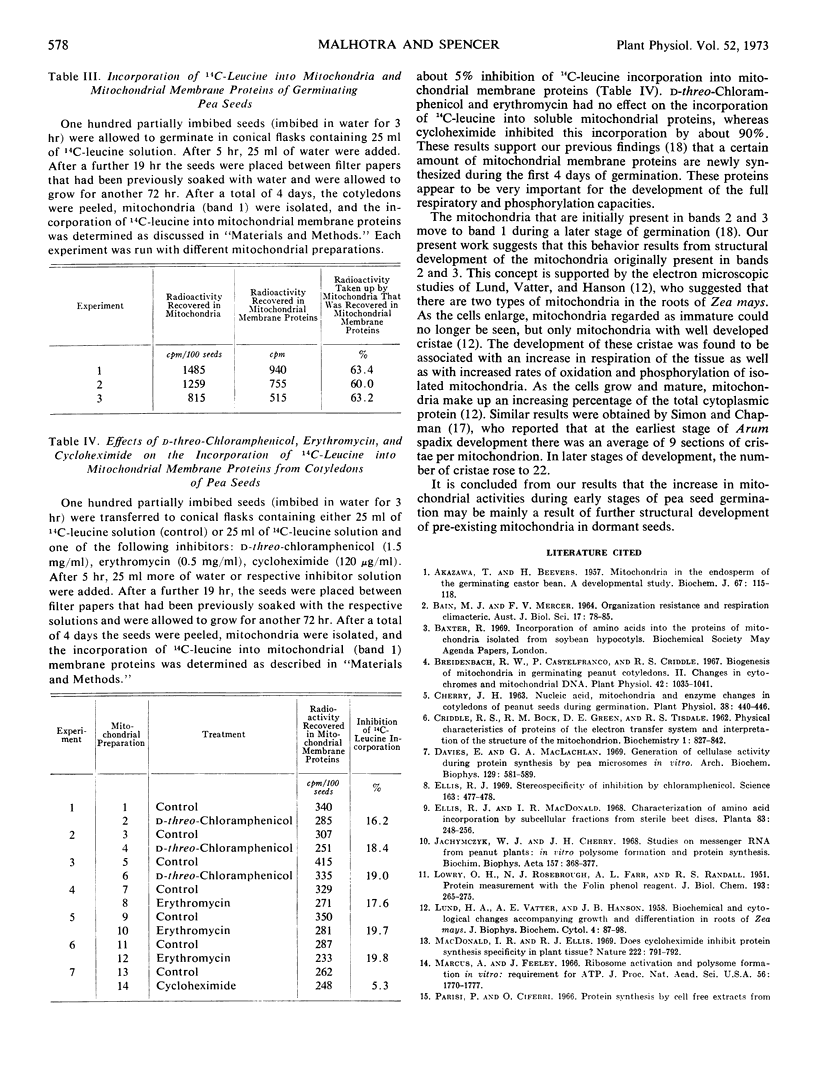Abstract
The crude mitochondrial fraction from pea cotyledons can, from days 1 to 7 of germination, be separated into three fractions by sucrose density gradient centrifugation. When seeds were grown in water (control) or cycloheximide (120 micrograms per milliliter of medium) for 4 days, the originally different populations of mitochondria acquired a uniform density and separated together in band 1 (density, 1.205 grams per milliliter). The oxidative and phosphorylative activities of mitochondria obtained from 4-day-old control and 4-day-old cycloheximide-treated pea seeds were the same. However, mitochondria from pea seeds that were grown in d-threo-chloramphenicol (1.5 milligrams per milliliter of medium) or erythromycin (0.5 milligram per milliliter of medium) for 4 days separate into three bands (fully developed mitochondria in the top band [band 1] and partially developed mitochondria in the lower two bands [bands 2 and 3]). Separation patterns and oxidative and phosphorylative activities were the same for mitochondria separated from 4-day-old cotyledons treated with d-threo-chloramphenicol or erythromycin and from 1-day-old cotyledons grown in water. This indicated that these inhibitors prevented the partially developed mitochondria originally in bands 2 and 3 from developing further. In contrast, cycloheximide did not seem to interfere with the mitochondrial structural development. These results along with those obtained from the experiments on the effects of d-threo-chloramphenicol, erthromycin, and cycloheximide on 14C-leucine incorporation into mitochondrial membrane proteins suggest that the increase in mitochondrial activity during germination may be a result of structural development (membrane synthesis) in pre-existing mitochondria.
Full text
PDF




Selected References
These references are in PubMed. This may not be the complete list of references from this article.
- AKAZAWA T., BEEVERS H. Mitochondria in the endosperm of the germinating castor bean; a developmental study. Biochem J. 1957 Sep;67(1):115–118. doi: 10.1042/bj0670115. [DOI] [PMC free article] [PubMed] [Google Scholar]
- Breidenbach R. W., Castelfranco P., Criddle R. S. Biogenesis of Mitochondria in Germinating Peanut Cotyledons II. Changes in Cytochromes and Mitochondrial DNA. Plant Physiol. 1967 Aug;42(8):1035–1041. doi: 10.1104/pp.42.8.1035. [DOI] [PMC free article] [PubMed] [Google Scholar]
- CRIDDLE R. S., BOCK R. M., GREEN D. E., TISDALE H. Physical characteristics of proteins of the electron transfer system and interpretation of the structure of the mitochondrion. Biochemistry. 1962 Sep;1:827–842. doi: 10.1021/bi00911a015. [DOI] [PubMed] [Google Scholar]
- Cherry J. H. Nucleic Acid, Mitochondria, & Enzyme Changes in Cotyledons of Peanut Seeds during Germination. Plant Physiol. 1963 Jul;38(4):440–446. doi: 10.1104/pp.38.4.440. [DOI] [PMC free article] [PubMed] [Google Scholar]
- Davies E., Maclachlan G. A. Generation of cellulase activity during protein synthesis by pea microsomes in vitro. Arch Biochem Biophys. 1969 Feb;129(2):581–587. doi: 10.1016/0003-9861(69)90217-3. [DOI] [PubMed] [Google Scholar]
- Ellis R. J. [Chloroplast ribosomes: stereospecificity of inhibition by chloramphenicol]. Science. 1969 Jan 31;163(3866):477–478. doi: 10.1126/science.163.3866.477. [DOI] [PubMed] [Google Scholar]
- Jachymczyk W. J., Cherry J. H. Studies on messenger RNA from peanut plants: in vitro polyribosome formation and protein synthesis. Biochim Biophys Acta. 1968 Apr 22;157(2):368–377. doi: 10.1016/0005-2787(68)90091-9. [DOI] [PubMed] [Google Scholar]
- LOWRY O. H., ROSEBROUGH N. J., FARR A. L., RANDALL R. J. Protein measurement with the Folin phenol reagent. J Biol Chem. 1951 Nov;193(1):265–275. [PubMed] [Google Scholar]
- LUND H. A., VATTER A. E., HANSON J. B. Biochemical and cytological changes accompanying growth and differentiation in the roots of Zea mays. J Biophys Biochem Cytol. 1958 Jan 25;4(1):87–98. doi: 10.1083/jcb.4.1.87. [DOI] [PMC free article] [PubMed] [Google Scholar]
- Marcus A., Feeley J. Ribosome activation and polysome formation in vitro: requirement for ATP. Proc Natl Acad Sci U S A. 1966 Dec;56(6):1770–1777. doi: 10.1073/pnas.56.6.1770. [DOI] [PMC free article] [PubMed] [Google Scholar]
- Schweyen R., Kaudewitz F. Protein synthesis by yeast mitochondria in vivo. Quantitative estimate of mitochondrially governed synthesis of mitochondrial proteins. Biochem Biophys Res Commun. 1970 Feb 20;38(4):728–735. doi: 10.1016/0006-291x(70)90642-x. [DOI] [PubMed] [Google Scholar]
- Solomos T., Malhotra S. S., Prasad S., Malhotra S. K., Spencer M. Biochemical and structural changes in mitochondria and other cellular components of pea cotyledons during germination. Can J Biochem. 1972 Jul;50(7):725–737. doi: 10.1139/o72-101. [DOI] [PubMed] [Google Scholar]
- Thomas D. Y., Williamson D. H. Products of mitochondrial protein synthesis in yeast. Nature. 1971 Oct 13;233(5320):196–199. [PubMed] [Google Scholar]
- Wilson S. B., Bonner W. D. Studies of electron transport in dry and imbibed peanut embryos. Plant Physiol. 1971 Sep;48(3):340–344. doi: 10.1104/pp.48.3.340. [DOI] [PMC free article] [PubMed] [Google Scholar]


